As you’ve decided to build your own product, you now need to make serious technical decisions. Having explored different ways to technically organize this process, you now need to choose between JavaScript and Ruby on Rails. You are probably wondering which one will help you launch your project faster, which technology is more cost-effective, and how they stack up in terms of performance, safety, and expandability.
JavaScript powers the web, dominating the front- and back-end. Rails is known for its speed, clean syntax, and ability to follow complex business logic efficiently.
To help you decide which tech stack to choose, we will explore the pros, cons, and ideal use cases for each option in this article. This way, you’ll be able to make a well-informed choice that fits your business needs. Let’s dive in!
Contents
- Overview of Ruby on Rails
- Ruby on Rails: Advantages
- Myths & Pitfalls to Consider about Ruby on Rails
- Ruby on Rails: Use Cases
- Overview of JavaScript
- JavaScript: Advantages
- JavaScript Limitations to Consider
- JavaScript: Use Cases
- RoR or JS?
- Final Thoughts
Overview of Ruby on Rails
Ruby on Rails (RoR) is not a language. It’s a framework with tools, structure, libraries, and modules to speed up development. RoR works with code in Ruby.
A Few Words about Ruby
Ruby stands out due to its intuitive, English-like syntax.
The language is interpreted instead of compiled, works across platforms, and uses dynamic typing. It also puts a big emphasis on object-oriented programming and comes packed with tools for creating, tweaking, securing, and managing objects.
Ruby is used in all kinds of development, but it’s best known for creating the back-end of websites and apps, especially with the Ruby on Rails framework.
Rails uses the same principles as Ruby:
- developers don’t need to specify every detail manually;
- the code should be concise and avoid repetition;
- a robust ecosystem of reusable components should speed up the development.
These fundamental principles make the framework a compelling option for web development. Its emphasis on convention enables developers to concentrate on creating features rather than dealing with repetitive code.
But what exactly makes RoR so popular among developers and businesses? Let’s delve into the key benefits that set it apart.
Ruby on Rails: Advantages
Evan Williams, co-founder of Twitter and its CEO from 2008 to 2010, as well as the creator of Blogger and Medium, shared that after exploring the market, Ruby on Rails emerged as the most suitable option. He expressed satisfaction with the decision and emphasized that they planned to keep leveraging Rails as a strategic advantage for their business.
He’s not the only entrepreneur who speaks so highly of this framework, and here’s why:
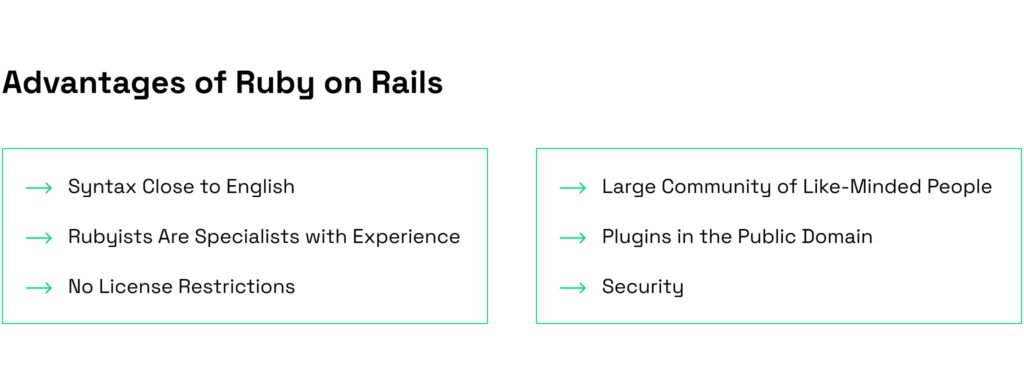
No Need to Adapt
RoR facilitates the creation of web applications for various systems (Windows, macOS, Linux) without extensive code adjustments. This is an advantage, as it lowers the expenses associated with development and maintenance. Some well-known companies use RoR to develop their cross-platform products. Among them a code hosting platform GitHub (utilizes RoR and JS), a home rental service Airbnb (built with RoR and React), an e-commerce platform Shopify (powered by RoR and Vue.js).

Syntax Close to English
Ruby on Rails is based on Ruby, which is simple and easy to use. The syntax of Ruby is straightforward and often resembles natural language. Writing in Ruby is a more enjoyable experience compared to, for instance, PHP. Let us illustrate this with an example:
class UsersController < ApplicationController
def create
user = User.new(name: "John", email: "[email protected]")
if user.save
render plain: "User created successfully!"
else
render plain: "There was an error creating the user."
end
end
end
Rubyists Have a Strong Technical Foundation
The entry barrier for Ruby is quite high, so developers typically switch to it after several years of work with other languages. Even a beginner Ruby developer typically has a strong technical background and solid skills.
No License Restrictions
RoR can be used without any licensing restrictions, which naturally reduces costs. Additionally, any developer can review the source code, identify vulnerabilities, and suggest fixes.
Large Community
Rails is a free and open-source project that benefits from the support of developers who are well-versed in best practices and eager to assist others. On Stack Overflow, there are over 338,000 questions about RoR, which highlight its strong community and ongoing relevance.
Plugins in the Public Domain
The framework has a lot of open-source plugins, or gems, that provide essential functionality. As of now, there are over 184,000 gems available, collectively downloaded more than 198 billion times. These gems range from low-level ones that handle specific aspects of an application’s internal processes to high-level ones that serve as standalone modules for solving various business tasks. This well-developed plugin system has been a key factor in the popularity of Ruby on Rails.
Native Security Capabilities
Rails 8 sets a new standard for web security. Its native security capabilities eliminate the need for external security tools, as they protect against common threats like session hijacking. Automatic updates and secure defaults make it easier to maintain strong security without extensive manual configuration. This comprehensive approach to security makes Rails a trusted choice.
For more information about using RoR in 2025, see the article Ruby on Rails Trends 2025: Key Updates and Insights
Myths & Pitfalls to Consider about Ruby on Rails
“Rumors of my demise have been greatly exaggerated”—a quip famously attributed to Mark Twain, but equally relevant today when discussing Ruby on Rails. Over the years, RoR has faced its share of skepticism, myths, and gloomy forecasts.
Yet, contrary to all predictions, it remains a cornerstone in tech, powering successful platforms and continuously attracting talented developers. Let’s examine and debunk some common misconceptions, alongside crucial insights about Ruby on Rails.

A Large Number of Myths
You’ve probably come across claims like “No developers,” “Too expensive,” “Slow,” or even “Ruby is dying” when reading about Ruby and the Ruby on Rails framework. These myths have been circulating online for the past eight years, yet companies (including us) continue to hire Ruby developers, and new, innovative products are still being built with Ruby. When comparing Ruby to languages like Python, Go, and Java, the number of developers is quite similar. Compared to .NET, Haskell, Elixir, and Perl, there are even more developers.
Different Opinions about Performance
Some experts claim that RoR is slower compared to frameworks like Node.js or Django. However, this statement isn’t entirely accurate. Performance issues may arise when a website has a large user base, but in such cases, speed depends more on how well the technology is implemented rather than the framework itself.
High Resource Costs
Ruby is a relatively resource-intensive language. Rather than being compiled into machine code prior to execution, it is interpreted during runtime, which means each command is analyzed and executed on the fly. Additionally, Ruby has dynamic typing, automatic memory management (garbage collection), and high-level abstractions. All of these features contribute to increased computational resource demands and memory consumption.
Ruby on Rails: Use Cases
Many well-known websites and apps have been built using RoR, including Airbnb, Bloomberg, Dribble, SoundCloud, Twitch, and GitHub. The framework powers content-sharing platforms, task management systems, booking services, e-learning platforms, news portals, and much more.
We’ve been specializing in Ruby on Rails since 2013, integrating it into a wide range of projects across different industries. Let’s take a look at some of our most recent implementations.
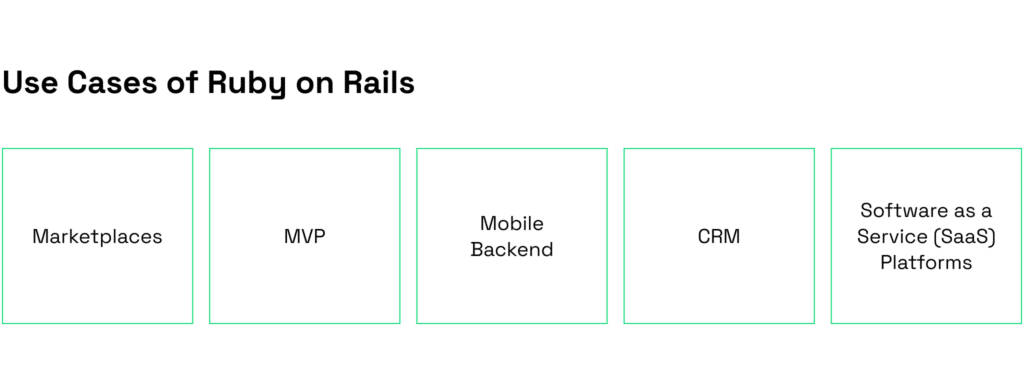
Marketplaces
Marketplaces are online platforms that allow users to conduct transactions and manage financial activities. These platforms handle vast amounts of data and require a substantial amount of time for development.
Rails is a good option in this context, as it offers tools and libraries that are tailored to handle user interactions, financial transactions, and intricate database connections.
When building the Yelz online store, we utilized Ruby on Rails for the backend, and it only took us two months to launch the initial version. However, RoR is an ideal choice for MVP in any industry, thanks to its clear and straightforward syntax.

MVP
As we mentioned earlier, if you have a startup and want to launch an MVP quickly, RoR is the way to go. Its modular architecture allows for much faster development. In our experience, it typically takes around two months.
Mobile Backend
Rails isn’t just for websites – it makes a solid backend for mobile apps too. It’s really good at handling databases, user logins, and building APIs. We actually used it for a food delivery app, and it handled everything smoothly – from processing orders and payments to tracking deliveries in real-time.
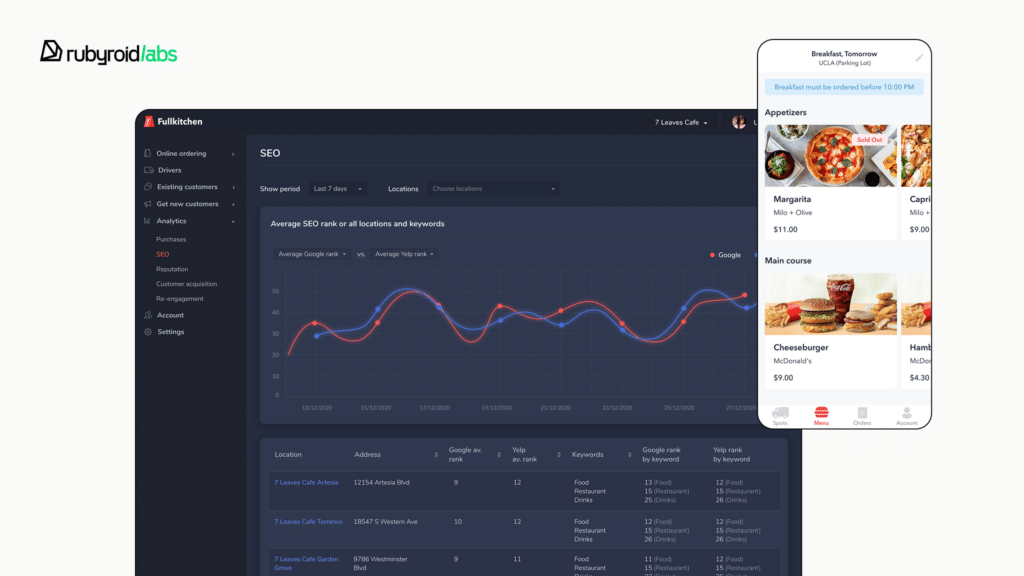
We also built the backend for Volvo’s car wash app using Rails. It handles everything – booking washes, picking different services like valeting, locking and unlocking your car remotely, checking your car’s health, and keeping track of where your vehicle is.

CRM
Rails is good for building CRMs – it’s flexible, scales well, and has tons of ready-to-use packages that make it easy to hook up with other tools. Plus, it plays really nice with stuff like payment systems, email tools, and analytics that you’ll definitely need in your CRM.
Software as a Service (SaaS) Platforms
Two key factors for the success of a SaaS product are speed and security. SaaS companies experience rapid growth, with annual rates of 50-60%. The codebase needs to be flexible enough to accommodate new demands and handle heavy loads. Ruby and Rails allow for quick functionality updates and smooth adaptation of services to changing requirements.
Here’s an example of a SaaS product we built using RoR. Veeqo, an inventory and shipping platform, helps e-commerce retailers automate their daily operations. Our team at Rubyroid Labs integrated their product with major services like Amazon, eBay, and Shopify via API, streamlining order and inventory management.
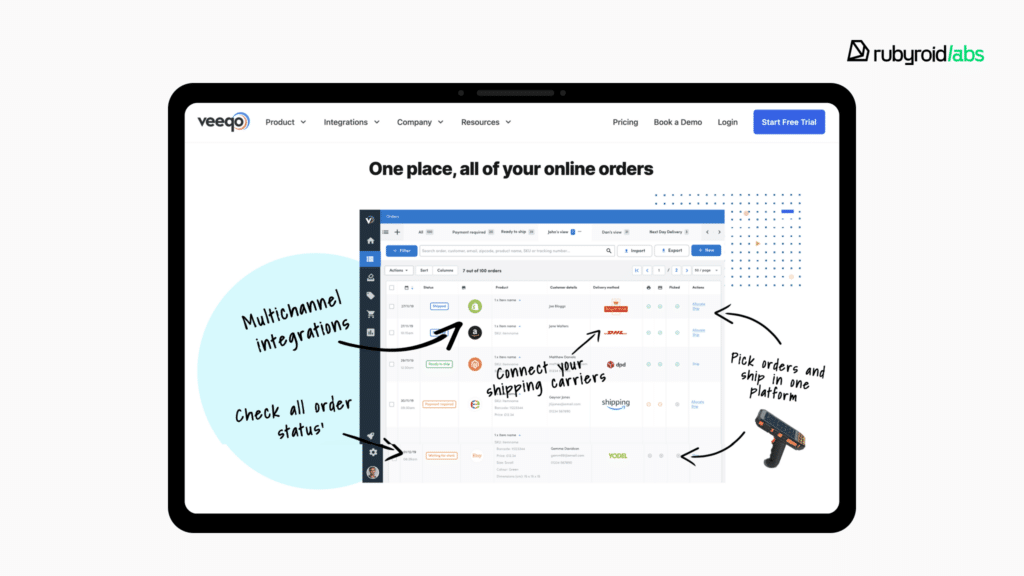
Overview of JavaScript
JavaScript (JS) is a programming language. There are plenty of statistics on this, and while the numbers vary slightly, JavaScript consistently ranks among the top 3 most widely used languages. According to GitHub, it was the 2nd most popular language among developers in 2024.
Just to clear things up, JavaScript and Java are not the same thing at all. They’re two completely different languages, each with their own unique purposes and functionalities.
JavaScript is used for both sides of development.
On the front-end, it controls website elements like loading effects, triggering animations, and changing button colors. In other words, it handles interactivity. When you click a ‘like’ button, the heart icon changes color and might animate. On Instagram, for instance, it even flashes. Actions like these are powered by scripts, which makes the name of language quite fitting.
On the back-end, JavaScript runs on the Node.js platform, an environment that allows JavaScript code to be executed server-side. With Node.js, developers can handle operations and use databases in order to build application servers.
Thanks to JavaScript and asynchronous AJAX requests, actions are performed without a full page reload.
We don’t have to refresh, for example, Google Docs after every small edit. Imagine how inconvenient that would be. We receive new messages in a chat without reloading it, see order status updates in an online store, and get endless content in a feed (when we scroll to the bottom, a new AJAX request is sent to the server, and fresh content loads in response). If JavaScript is disabled in the browser, nothing happens.
JavaScript: Advantages
JavaScript continues to be a popular choice for a reason. It allows developers to build versatile products using a single language, which in some cases can be cost-saving for you as a business owner.
Here are the reasons why companies choose JavaScript for building their websites and apps:
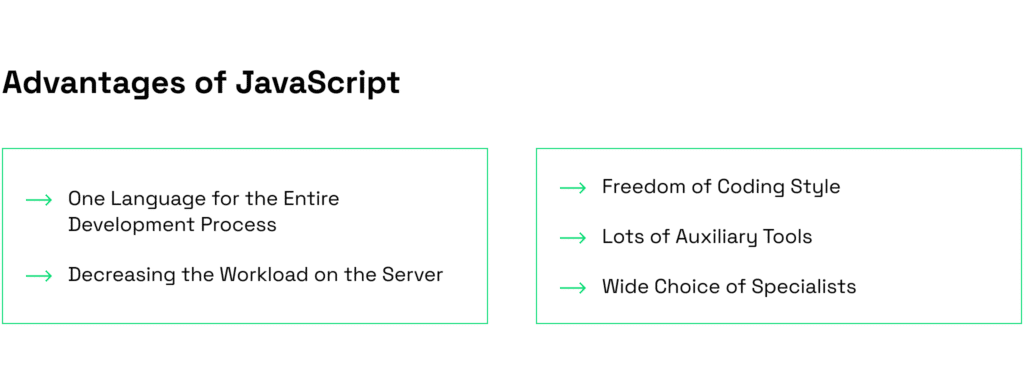
One Language for the Entire Process
A full-stack JavaScript developer can do everything on their own: build a website, animate it, and assemble the entire back-end. JS, along with its frameworks and libraries, gives developers the ability to work on both the front-end (what users see) and the back-end (servers and databases).
Decreasing the Workload on the Server
Web pages are partially processed using JavaScript on the user’s computer. This lets certain tasks run without having to ping the server, which takes some pressure off, speeds things up, and saves on bandwidth.
Freedom of Coding Style
In programming, there are three main paradigms or coding styles: object-oriented, functional, and imperative. JavaScript supports all of these paradigms, giving developers greater flexibility in how they write code.
From a business perspective, this kind of flexibility translates to quicker development times and easier upkeep. Object-oriented programming lets you reuse pieces of code in different areas, even across different projects, which really accelerates the whole process. And functional programming helps create programs that are more reliable and easier to test and maintain.
Object-oriented. A program is considered to be a group of “entities”, similar to tangible objects in the physical world. For example, in an online shopping application, there might be a “product” entity with attributes (such as price and name) and operations (like adding it to the shopping cart). The entire system operates through these entities interacting with one another.
Let’s create a Product class with attributes and a method for adding it to the cart:
class Product {
constructor(name, price) {
this.name = name;
this.price = price;
}
addToCart() {
console.log(`${this.name} has been added to the cart.`);
}
}
const laptop = new Product("Laptop", 1200);
laptop.addToCart(); // "Laptop has been added to the cart."
Functional. A program is built as a set of functions (instructions) that take input, process it, and return a result. For instance, a function “calculate order total” simply takes the prices of all products and adds them up without modifying the products themselves.
The calculateOrderTotal function takes an array of prices and returns the total sum without modifying the input data:
const calculateOrderTotal = (prices) => prices.reduce((total, price) => total + price, 0);
const prices = [100, 200, 50];
console.log(calculateOrderTotal(prices)); // 350
Imperative. In this case, a developer explicitly tells the program what to do step by step. For example, an instruction on how to make tea in an imperative style might be: boil water, brew tea, add sugar, and stir.
function makeTea() {
console.log("Boil water");
console.log("Brew tea");
console.log("Add sugar");
console.log("Stir");
}
makeTea();
// Output:
// Boil water
// Brew tea
// Add sugar
// Stir
These instances clearly demonstrate the contrast between the methods. In the first case, we work with objects and their methods. In the second, we use pure functions and immutable data. In the third one, we provide step-by-step instructions.
Lots of Auxiliary Tools
A broad range of libraries and frameworks has emerged in the JavaScript ecosystem, including React, Angular, and Vue.js. Frameworks provide templates that developers can use as a starting point for their projects. This approach saves them time and effort compared to starting from scratch. For businesses, this means faster development and lower costs, especially when we speak about hourly wages.
JavaScript Limitations to Consider
No matter how good a language is, it will always have its flaws. Bjarne Stroustrup, the creator of C++, pointed out that every programming language either faces criticism or gets ignored entirely.
Popular languages (JS being one of them) are widely used, which means developers constantly find flaws and criticize them. The more people use a language, the more criticism it gets. Unpopular languages don’t get complaints simply because they don’t have a large enough audience to point out their shortcomings.
So, let’s take a look at some of JavaScript’s shortcomings.
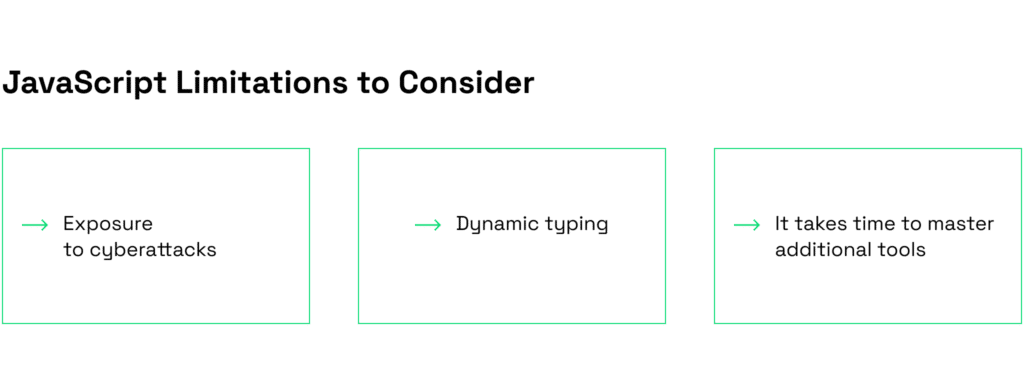
May Face Cyberattacks
JavaScript is often a target for hackers because of its popularity. Web apps built with JavaScript can be at risk for things like XSS (Cross-Site Scripting), CSRF (Cross-Site Request Forgery), and other security threats.
XSS attacks happen when hackers sneak malicious code into a web page, which then runs on the user’s side. This can let them steal data, hijack sessions, or even run random commands.
CSRF attacks trick users into doing things they didn’t mean to do on a website where they’re already signed in, like submitting a form with a harmful request.
To prevent such threats, developers must implement additional security measures.
May Be Unpredictable Due to Dynamic Typing
Every programming language has data types: strings, numbers, characters, etc. The way a language handles these types is called typing.
In statically typed languages, you must define a variable’s type before using it.
JavaScript, on the other hand, uses dynamic typing, meaning no need to specify types. This is both an advantage and a drawback. The catch is that it makes mistakes more likely, and those can be tougher to spot.
It Takes Time to Master Additional Tools
Once again, this is both an advantage and a drawback. To fully leverage JavaScript’s capabilities, you need additional tools. There are many of them, and making sure they work well together and interact correctly can be challenging even for senior developers.
For those just starting out, it takes time and dedication to master these tools before they can even approach the level of a junior professional.
JavaScript: Use Cases
JS is frequently referred to as the foundation of the contemporary web, and rightfully so. Initially created to make web pages interactive, it has transformed into a language that operates both on the client and server sides.
Let’s explore the diverse ways JavaScript is used across different domains.

Frontend
JavaScript is employed to develop the user interface of web applications and websites.
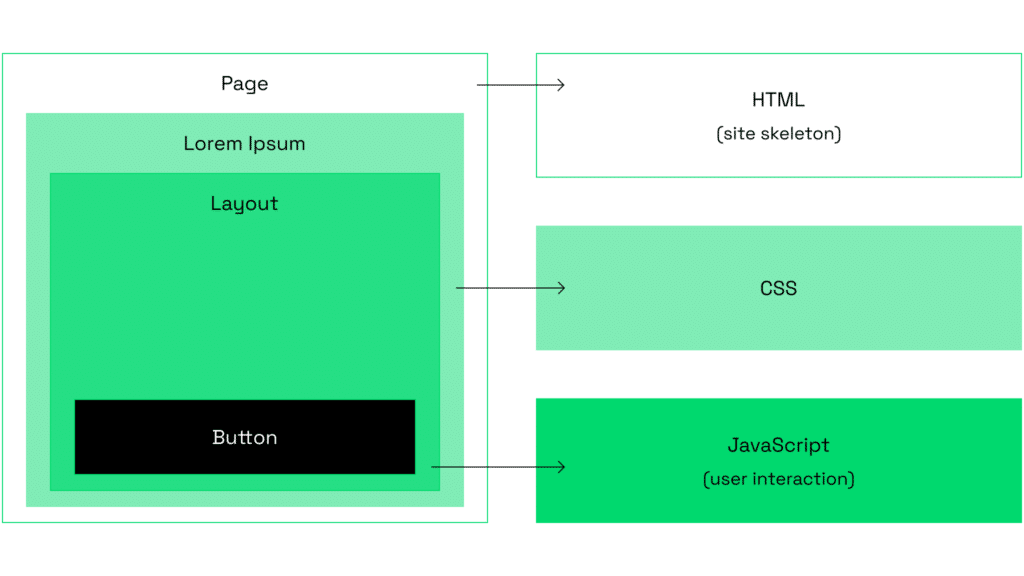
A web application is a program that runs inside a browser, so it doesn’t need to be downloaded. This means you can access it from any device as long as you have an Internet connection. Unlike regular websites, web apps come with more advanced features and interactive elements, they take longer to build.
JS is what runs the code for some of the biggest services out there, like the task management tool Trello, the content-sharing platform Pinterest, the massive stock photo library Shutterstock, and many others.
We used JavaScript for the frontend of an e-commerce beauty store, utilizing Node.js, Next.js, React, and Jest. Our team implemented online payment processing, integrated the platform with a CRM, and connected it to the warehouse system to streamline operations. Check out the full case study here: Yelz Case Study.
React was also used in another project, Chatchamp, a marketing software for online stores that use chatbots to increase sales. It won 1st place for “Innovation of the year” at the E-Commerce Germany Awards 2019 and raised funding in the Series B investment round.

Backend
Besides the user interface that people see, web applications also have a behind-the-scenes part, the backend, which is where all the databases are kept.
JavaScript allows communication with a server by sending requests and receiving responses using AJAX technology. For example, when building a clinic’s website, users should be able to click on a date in the calendar and see available appointment slots without needing to refresh the whole page.
JavaScript uses Node.js, a runtime environment for executing server-side code. It’s turned JS from a language that was just for frontend work into a language that can do pretty much anything. JavaScript combined with Node.js is used by companies like eBay, PayPal, and Walmart.
Currently, our development team is working on a blockchain-based payment platform that enables transparent transactions. The client approached us with an existing application that needed fixes and functional improvements. To address these issues, we are rewriting part of the backend using Node.js, performing debugging, and adding new features.
Add-ons for Browsers
Browser add-ons are compact programs composed of code that operates within the browser. These add-ons assist us in blocking advertisements, capturing screenshots, downloading videos, monitoring time spent online, and automatically translating web pages. Most of them are built using JavaScript.
Mobile Apps
React Native permits writing JavaScript code for mobile platforms. This way, it’s possible to create apps that work across both iOS and Android.
This is a big win for businesses, especially startups, since they don’t have to hire different developers for each platform. Instead, they can create a single app that works on every device. The LinkedIn app, for example, is written using JavaScript.
Games
JavaScript is what powers basic games, such as “2048” and the dinosaur in Google Chrome that jumps over cacti when the Internet is down. These types of games are relatively simple and require minimal graphics and processing power. For more complex games with advanced graphics, physics, and real-time interactions, JS is less suitable.

Smart Devices
JavaScript is well-suited for programming devices we use at home and work, such as smartwatches, fitness trackers, security systems, cameras, robotic vacuums, and smart speakers. Frameworks like Cylon.js (used for robotics, hardware computing, and IoT) and Johnny-Five (designed for microcontroller-based hardware) enable JavaScript to power these technologies.
RoR or JS?
Both are indispensable instruments in the development workflow. Each has its own advantages, specific applications, and a dedicated user base. Picking one over the other isn’t about finding which one is better – it’s about selecting the tool that best fits the needs of your project.
This table compares the important features of each, so you can pick the one that works best for you.
| Criteria | JavaScript | Ruby on Rails |
| Primary Purpose | Full-stack development | Full-stack development |
| Key Strengths | Full-stack capabilities Wide compatibility across browsers and devices Asynchronous operation with AJAX Large ecosystem of frameworks and tools | Convention over configuration Rapid development with built-in tools Security Concise syntax |
| Frontend Development | Used for frontend development. | Rails can generate HTML views with embedded Ruby, making it an integral part of the frontend delivery process. |
| Backend Development | Node.js allows JavaScript to handle server-side logic, APIs, databases, and real-time data operations. | RoR excels in building complex back-end systems with ease, especially for database-heavy applications. |
| Performance | JavaScript is interpreted, which can lead to performance issues with complex operations. | Ruby’s interpreted nature may lead to higher resource consumption; however, proper implementation minimizes performance gaps. |
| Scalability | JavaScript (via Node.js) can scale horizontally and handle many concurrent connections. | RoR supports scalability but may require more optimization for very large applications. |
| Security | JavaScript applications may face vulnerabilities like XSS and CSRF attacks. Additional security measures are required. | RoR provides built-in security features to prevent common attacks like CSRF, SQL injection, and XSS. |
| Development Speed | JavaScript’s versatility allows quick development for both front-end and back-end with a single language. | RoR’s convention-based development accelerates the creation of web applications. |
| Cost Efficiency | Cost-effective as it allows developers to handle both front-end and back-end development using the same language, which reduces the need for additional resources. | Open-source nature reduces licensing costs. |
| Best Use Cases | Web applications Mobile apps (via React Native) Browser extensions Internet of Things (IoT) | Web back-end systems CRMs Marketplaces SaaS platforms MVP development for startups |
10-20 years ago, the choice of technology really impacted a product’s success. Many big names emerged partly due to Ruby on Rails, while their competitors, using different languages and frameworks, fell behind.
Today’s startups can succeed using pretty much any programming language. What really matters is having a solid idea that your customers want and a skilled tech team that can bring it to life.
If you’re sitting on a fantastic idea, Rubyroid Labs software development company is ready to help you build it the right way. Contact us to discuss the details.
Final Thoughts
It’s tough to pit Ruby on Rails vs JavaScript, as they’re meant to solve different problems. These two technologies work together in almost all of our projects. Ruby on Rails handles the backend and JavaScript manages the frontend. Using one without the other creates significant limitations, as both are essential for a fully functional, dynamic application.
The right technology for your product depends on your business goals, expectations, and target audience. Making this decision on your own can be challenging, and without the right expertise, it’s easy to waste time and miscalculate your budget. To determine the best technical approach for your product, you’ll need expert guidance from professionals. Only developers can choose the optimal solution for a specific project type that’s tailored to your needs.
We’ve been working with Ruby on Rails and JavaScript for 12 years. If you need a consultation, MVP development, or a fully-fledged product, our team of middle and senior developers is always ready to collaborate.







